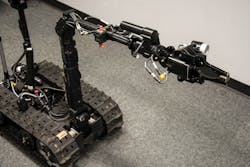By Tom Curatolo, Vicor Principal Field Applications Engineer, and David Berry, Vicor Principal Applications Engineer
Robotics make vital contributions to the economy in manufacturing, delivery, warehouse inventory management, and agriculture harvesting. Most mobile robots are fueled by batteries, which means the available energy is limited and the need for periodic recharge restricts the robot’s active time. Efficiency in power conversion is therefore critical, but it is only one aspect of power conversion that can significantly impact the performance, functionality, and reliability of mobile robots. A well-designed power-delivery network (PDN) not only improves efficiency, it also reduces weight and size, enabling extended range and freeing up space for larger payloads and more functionality.
Today’s payload demands exceed the capabilities of traditional power-system designs. Robotics designers need a better way to deliver power using PDNs based on leading-edge topologies, architectures, and packaging. Module-based PDNs are smaller, lighter, more efficient, and more flexible than conventional bricks, which makes building ever-more-capable robots possible. Module-based PDNs are also easier to implement than discrete solutions, which shortens time-to-market.
Vicor is the industry leader in module-based PDN design. Read on as we answer common questions about modular PDNs for robotic applications.
What are the key challenges faced by engineers working on Robotics, which your proposed solutions aim to solve?
The key challenge we see facing engineers today is the demand for smaller, lighter-weight, higher-power designs. In many applications, there is a need to carry a larger payload (a variety of enhanced and complex electronics such as sensors, cameras, tools with communications, and control). In addition, the robot needs to be smaller and lighter to make it easier to transport and robust enough to deal with various environments.
Such applications often involve remote operation, performance of intricate tasks, and risks from failure, which combine to put an emphasis on the need to improve data transmission speed, sensor accuracy, and image quality. Management of power-supply EMI typically is a fundamental requirement as well.
The world of manufacturing is changing, driven by various Industry 4.0 initiatives. With this development, closely coupled and internet-supported robotic solutions must be addressed. The flexible networking of previously sequential, belt-supported production processes using mobile robots, known as autonomously guided vehicles (AGVs), and the direct collaboration of humans with robots using flexible, collaborative robot systems are of particular significance for the change.
In addition to making those production systems more flexible, engineers are striving to increase uptime even further. The demands on automation solutions, for instance individual subsystems such as robots, drives, charging systems for mobile autonomous robots, as well as power distribution, contribute to the increased demand for system efficiency.
We aim to solve these challenges through Vicor next-generation power modules that deliver higher density and higher efficiency than other DC-DC converters.
How many products are focused on the Robotics space?
Vicor offers a variety of power modules that address the demands of Robotic applications with either DC or AC input requirements. The DCM™ DC-DC converter product family offers significant improvement over competitive DC-DC converter solutions.
In addition, increased power density can be achieved with the PRM™ regulator, a high-performance buck-boost regulator. The PRM creates an intermediate bus of 24 to 48 V with 96% to 98% efficiency to power servos and downstream power modules, including fixed-ratio NBM™ bus converters and zero-voltage-switching ZVS Buck and ZVS Buck-Boost regulators. These modules can also be paralleled for higher-power conversion.
For each product, can you also indicate the applications for which they are best suited?
Typically, each product has specific attributes; the design goal of the engineer will dictate which module(s) provide the overwhelming advantage. Vicor products and modular power design strategies have been ideally suited for many robotic applications, including bomb disposal, agricultural harvesting, warehouse inventory movement, campus delivery, and consumer delivery.
Some of those applications are tethered or use wiring harnesses for power delivery. Other applications employ robots that are powered by batteries, making power-conversion efficiency—along with size and weight—critical.
A modular power approach makes it easy to address challenges like load capacity, placement, and user functionality requirements. Vicor offers an online selector tool called the Power System Designer to aid in selecting the appropriate architecture and specific modules(s) to optimize a PDN for specific application needs.
If design engineers want to review your solutions for designs that they are currently working on, do you offer any simulation or assistance?
Yes, Vicor offers valuable tools online for simulations and assistance using thermal management and module calculators. In addition, we offer demo boards, and our applications engineers are available to assist with design reviews.
For design engineers who want samples, do you supply them directly or can they buy from leading catalogue distributors?
Standard product samples can be ordered from Digi-Key, Mouser, and Arrow, plus solutions for Robotic systems can be discussed thoroughly with the Vicor applications engineering team.
Why should your customers avoid designing their own power system themselves?
We achieve high power density, efficiency, and thermal management through advanced proprietary topologies and packaging. In addition, we achieve high quality and reliability through disciplined, automated manufacturing. It would be difficult to achieve the same power density and efficiency without access to Vicor intellectual property and manufacturing expertise.
Any pricing indicators that you can share with our audience?
Pricing depends on a number of factors, including qualification requirements and an OEM’s implementation of the PDN using combinations of Vicor modules. Customers will realize considerable cost savings with a Vicor modular solution, which helps reduce overall system cost.
For more information, please visit vicorpower.com/robotics
